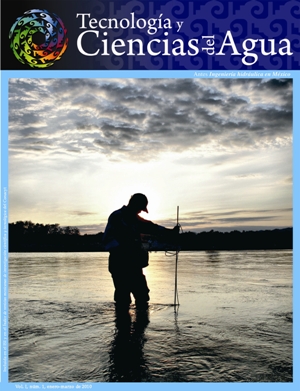A simple and useful modification of the index flood method.
DOI:
https://doi.org/10.24850/j-tyca-2010-01-06Keywords:
index flood method, Langbein test, regional homogeneity, regionalization, Lerma-Santiago river basinAbstract
The index flood method is a hydrologic regionalization technique widely used in the world. The method, which was originally proposed by the U.S. Geological Survey, was developed based on the application of the Langbein homogeneity test. Its general application steps are the definition of the homogeneus region, the determination of an index flood, the generation of a regional frequency curve, and the use of various relationships between physiographic characteristics of the basin and the so called index flood. Over time, many advantages have been recognized for the method, but some deficiencies have also been identified. It is common, for example, that the inclusion of a certain station in the analysis of an initial group of stations causes some of the other stations to fall out of the homogeneous region, or vice versa, not including a certain station can produce some others to become part of the homogeneous region. This anomalous behaviour of the method is the main issue of this work. In the paper, a simple but useful modification of the original method is proposed. The use of a "filtering" procedure avoids the inclusion, from the outset, of those stations that impose serious deviations to the method. The use of this filter not only generates bigger homogeneous regions, but also regions with a better homogeneity. Furthermore, through a cross validation technique, it was shown that the discharge estimates of ungauged basins within the region are much better than those obtained with the original version of the method.References
ARELLANO, F. Sistematización del método de la avenida índice y su aplicación en cuencas de la región Lerma-Santiago. Tesis de maestría en Ingeniería. México, D.F.: UNAM, Campus Morelos, 2006.
ARELLANO, F., RAMÍREZ, A. y VELÁZQUEZ, J. Implementación del método de la avenida índice en un SIG y ejemplo de aplicación. XXII Congreso Latinoamericano de Hidráulica, Ciudad Guayana, Venezuela, octubre, 2006.
BANDAS. Banco de Datos de Aguas Superficiales. Jiutepec, México: IMTA-CONAGUA, 1999.
BOCCHIOLA, D., DE MICHELE, C. and ROSSO, R. Review of recent advances in index flood estimation. Hydrology and earth system sciences. Vol. 7, no. 3, 2003, pp. 283-296.
CUNNANE, C. Methods and merits of regional flood frequency analysis. J. Hydrol. Vol. 100, 1988, pp. 269-290.
DALRYMPLE, T. Flood frequency analysis. USG Water Supply Paper. 1543-A, USGS, Reston, Va., 1960, 80 pp.
GIOIA, A., FIORENTINO, M., IACOBELLIS, V. and MARGIOTTA, M. Theoretical derivation of the index flood. Advances in Geosciences 2. Vol. 2, 2005, pp. 249-253.
GREENWOOD, J., LANDWEHR, J., MATALAS, M. and WALLIS, J. Probability weighted moments: distribution and relation to parameters of several distributions expressable in inverse way. Water Resources Research. Vol. 15, no. 5, 1979, pp. 1049-1054.
GREHYS (Groupe de Recherche en Hydrologie Statistique). Intercomparison of regional flood frequency procedures for Canadian rivers. Journal of hydrology. Vol. 186, no. 1-4, 1996a, pp. 85-103.
GREHYS (Groupe de Recherche en Hydrologie Statistique). Presentation and review of some methods for regional flood frequency analysis. Journal of hydrology. Vol. 186, no. 1-4, 1996b, pp. 63-84.
GUTIÉRREZ, A. y RAMÍREZ, A.I. Predicción hidrológica mediante el método de la avenida índice para dos poblaciones. Ingeniería hidráulica en México. Vol. XX, núm. 2, abril-junio de 2005, pp. 37-47.
HEO, J., SALAS, J. and BOES, D. Regional flood frequency analysis based on a Weibull model. Part 2. Simulations and applications. Vol. 242, no. 3-4, 2001, pp. 171-182.
HOSKING, J. and WALLIS, J. Regional Frequency Analysis –An approach based on L-Moments. Cambridge: Cambridge University Press, 1997.
KITE, G.W. Frequency and risk analyses in hydrology. Littleton, USA: Water Resources Publications, 1988.
KJELDSEN, T., SMITHERS, J. and SCHULZE, R. Regional flood frequency analysis of the KwaZulu-Natal province, South Africa, using the index flood method. Journal of Hydrology. Vol. 255, no. 1-4, 2001, pp. 194-211.
MAIDMENT, D. Handbook of Hydrology. New York: McGraw-Hill, 1993.
PARIDA, B., KACHROO, R. and SHRESTHA, B. Regional flood frequency analysis of Mahi-Sabarmati basin (subzone 3-A) using the index flood procedure with L-moments. Water Resources Management. Vol. 12, 1998, pp. 1-12.
POTTER, K.W. and LETTENMAIER, D.P. A comparison of regional flood frequency estimation methods using a resampling method., Water Resour. Res. Vol. 26, no. 3, 1990, pp. 415-424.
SVEINSSON, O., BOES, D. and SALAS, J. Population index flood meted for regional frequency analysis. Water Resources Research. Vol. 37, no. 11, 2001, pp. 2733-2748.
VIESSMAN, W., KNAPP, J., LEWIS, G. and HARBAUG, T. Introduction to hydrology. New York: Harper & Row Publishers, 1989.
Downloads
Published
How to Cite
Issue
Section
License
Copyright (c) 2010 Tecnología y ciencias del agua

This work is licensed under a Creative Commons Attribution-NonCommercial-ShareAlike 4.0 International License.
By Instituto Mexicano de Tecnología del Agua is distributed under a Creative Commons Attribution-NonCommercial-ShareAlike 4.0 International License. Based on a work at https://www.revistatyca.org.mx/. Permissions beyond what is covered by this license can be found in Editorial Policy.









